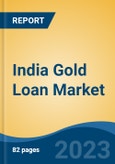Speak directly to the analyst to clarify any post sales queries you may have.
10% Free customizationThis report comes with 10% free customization, enabling you to add data that meets your specific business needs.
India, with over 27,000 metric tonnes of gold held domestically - approximately 14% of global gold stock - presents a substantial untapped potential. Despite this, only a fraction has been monetized through the organized lending sector. The disparity between available gold assets and active loan penetration underscores a vast growth opportunity for formal lenders. Leading players such as Muthoot Finance, Manappuram Finance, and IIFL are rapidly expanding operations to capture this potential. The market is also benefiting from a shift in borrower preferences toward formal, transparent, and regulated lenders.
Key Market Drivers
High Gold Ownership Among Indian Households
India’s cultural and financial attachment to gold continues to be a primary growth driver for the gold loan market. With an estimated 25,000-27,000 tonnes of gold in household possession, gold remains the preferred store of wealth for many, especially in rural and semi-urban areas. These assets, mostly in the form of jewelry, are increasingly being leveraged to meet immediate financial needs without selling them.Gold loans offer fast disbursal, minimal paperwork, and flexible repayment options, making them an attractive credit alternative for small business owners, farmers, and families managing unforeseen expenses. Additionally, the rising gold prices in recent years have enhanced the loan-to-value ratio, allowing higher loan amounts against the same quantity of gold. In 2024, India’s gold consumption surpassed 800 tonnes, with bars and coins alone accounting for 239 tonnes, reflecting the sustained relevance of gold as both an investment and credit instrument.
Key Market Challenges
Fluctuations in Gold Prices
Volatility in gold prices presents a significant risk to the stability of the gold loan market. While an increase in gold value benefits borrowers by improving loan eligibility, a sharp decline can trigger collateral-related challenges for lenders. A decrease in gold prices reduces the margin of safety for lenders, potentially leading to under-collateralization and increased risk of default. In such cases, institutions may need to recover dues through auctions or demand additional collateral, which could result in borrower dissatisfaction and reputational risk. For borrowers, falling gold prices can reduce their ability to secure top-up loans or refinance existing ones, particularly in periods of financial distress. These dynamics often lead lenders to adopt conservative loan-to-value (LTV) ratios, limiting borrowing flexibility and impacting market growth during periods of price instability.Key Market Trends
Volatility in Gold Prices
The ongoing price volatility of gold continues to shape lender strategies and borrower behavior in the Indian gold loan segment. Fluctuations in the market directly impact the LTV ratio, which in turn affects the maximum loan amount sanctioned against the pledged gold. When prices fall, lenders face elevated risks and may require top-up collateral or initiate recovery actions through auctions. Borrowers, especially those from rural or lower-income segments, face added financial pressure when their pledged asset depreciates in value.As a result, gold loan providers have become increasingly cautious, preferring more conservative valuations and robust monitoring of their loan portfolios. Companies like Poonawalla Fincorp, with a presence across 18 states and two Union Territories and AUM nearing USD 2.8 billion, are entering the segment with a focus on secured lending and risk-managed expansion. This reflects a broader industry trend toward strengthening portfolio resilience while catering to evolving borrower needs.
Key Market Players
- Muthoot Finance Ltd
- Manappuram Finance Ltd
- Union Bank of India
- State Bank of India
- Kotak Mahindra Bank Ltd.
- ICICI Bank Ltd.
- HDFC Bank Ltd
- AXIS Bank Ltd.
- Central Bank of India
- Federal Bank Ltd
Report Scope:
In this report, the India Gold Loan Market has been segmented into the following categories, in addition to the industry trends which have also been detailed below:India Gold Loan Market, By Type of Lenders:
o Visa
o Mastercard
o RuPay
o Others
India Gold Loan Market, By Mode of Disbursal:
o Cash
o Cheque
o E-Transfer
India Gold Loan Market, By Market Type:
o Organized
o Unorganized
India Gold Loan Market, By Interest Rate:
o Up to 10%o 11%-20%
o Above 20%
India Gold Loan Market, By Region:
o North
o South
o East
o West
Competitive Landscape
Company Profiles: Detailed analysis of the major companies present in the India Gold Loan Market.Available Customizations:
With the given market data, the publisher offers customizations according to a company's specific needs. The following customization options are available for the report.Company Information
- Detailed analysis and profiling of additional market players (up to five).
This product will be delivered within 1-3 business days.
Table of Contents
Companies Mentioned
- Muthoot Finance Ltd
- Manappuram Finance Ltd
- Union Bank of India
- State Bank of India
- Kotak Mahindra Bank Ltd.
- ICICI Bank Ltd.
- HDFC Bank Ltd
- AXIS Bank Ltd.
- Central Bank of India
- Federal Bank Ltd
Table Information
| Report Attribute | Details |
|---|---|
| No. of Pages | 70 |
| Published | July 2025 |
| Forecast Period | 2025 - 2031 |
| Estimated Market Value ( USD | $ 80.29 Billion |
| Forecasted Market Value ( USD | $ 157.6 Billion |
| Compound Annual Growth Rate | 11.9% |
| Regions Covered | India |
| No. of Companies Mentioned | 10 |









